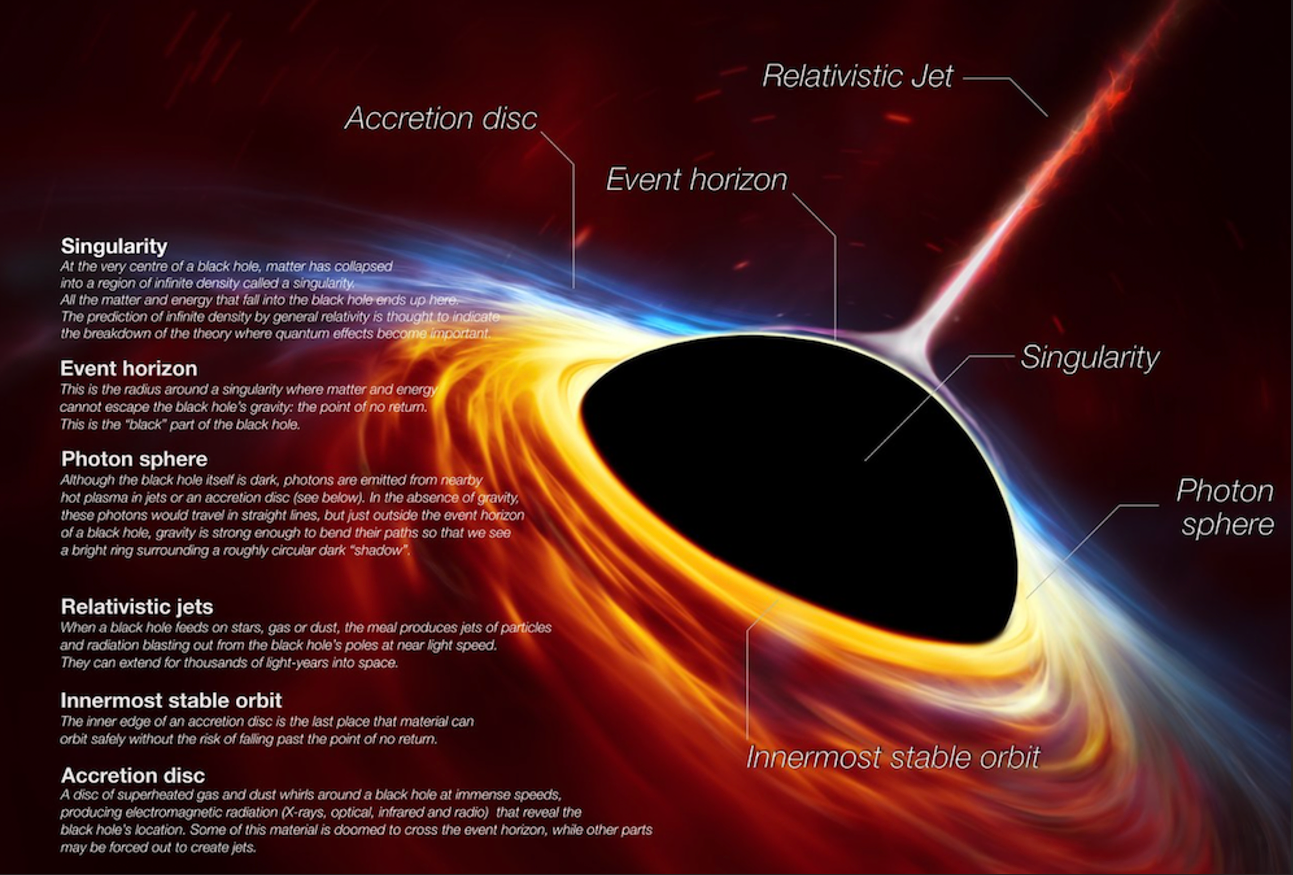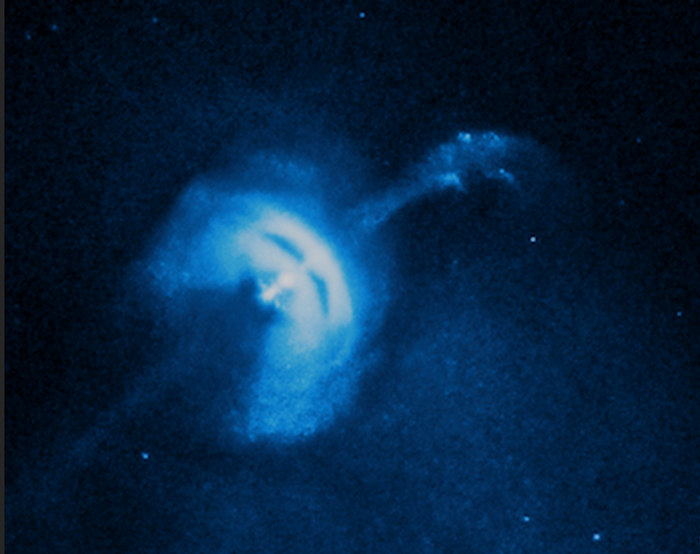Blackhole, a region in space so strong even light cannot escape. The idea of an object in space, massive and dense has been around for centuries. Black holes were predicted by Einstein’s theory of general relativity, which showed that when a massive star dies, it leaves behind a small core. The blackhole equations show that if the core’s mass is more than three times the mass of our sun, strong gravitational forces work to produce a blackhole.
Detecting a Blackhole
Unfortunately, blackholes cannot be detected directly through telescopes capturing electromagnetic radiation. The presence of a blackhole is observed through studying its effect on nearby celestial objects. If a star passes close to a blackhole, the gravitational effects can tear the star apart pulling it towards itself. Similar to if a blackhole were to pass through an interstellar cloud, it will draw matter inwards, this process is known as accretion.
Anatomy of a Blackhole
A blackhole has six main components responsible for its turbulent nature.

Anatomy of Blackhole
Singularity: Matter collapses into a region of infinite density at the centre of a blackhole. Infinite density has been predicted to exist through general relativity, where quantum effects must be acknowledged.
Event Horizon: Radius around a singularity, matter, and energy (light) are unable to escape the black hole’s gravity. This is the ‘black’ part of the blackhole.
Photon sphere: In the absence of gravity, photons would follow a straight path. However, outside the event horizon, gravity is strong enough to change the direction of photons. Photons bend across the event horizon forming a bright ring.
Relativistic jets: When a blackhole consumes stars, gas or dust, jets of particles and radiation blast outwards from the black hole’s poles. They may extend for thousands of light-years in space.
Accretion disc: A disc of superheated gas and dust whirls around a blackhole at immense speeds. Electromagnetic radiation (x-rays, optical, infrared, and radio waves) are produced that reveal the black hole’s position in space.
Innermost stable orbit: The inner edge of an accretion disc is the last place where matter can orbit safely, without the risk of falling past the point of no return.
Death of a star
Stars are known to form helium atoms by fusing hydrogen atoms together, this process is called nuclear fusion which releases immense amount of energy. As the hot gas pushes outwards, it opposes the force of gravity. Once a star starts running out of hydrogen atoms to fuel its survival, it induces a supernova explosion.

Vela Pulsar| Creator: Chandra X-ray Observatory centre| Credit: NASA/CXC/ Univ of Toronto
Smaller stars, less than three times our sun, are unable to trap light, and hence form neutron stars. Except for blackholes, neutron stars are the smallest and densest known class of stellar objects. A highly magnetized rotating neutron star is called a pulsar, it emits beams of electromagnetic radiation from its magnetic poles. A pulsar can only be observed when the beam of radiation points towards Earth, the radiation ranges in intervals typically from milliseconds to seconds. That radiation is then detected and analysed, through radio telescopes, by astronomers.

Supernova remnant
Opposing forces, such as electron degeneracy, are unable to stop stars, with a total mass of 3 solar masses or greater, three times our Sun, from collapsing under the influence of gravity. As the surface of the star reaches an illusionary event horizon, the star slows relative to the time of observers at a distance. Observers, examining the supermassive star collapsing, would notice the rate of process decreases as the star reaches an imaginary event horizon. When the surface extends completely to the event horizon, the star would no longer be able collapse further, forming a blackhole. This process is called a supernova explosion.
Blackholes in Milky way
Observational evidence indicates that almost every large galaxy has a supermassive black hole at its centre. Sagittarius A*, SrgA*, is a supermassive black hole located at the centre of our spiral galaxy, the Milky Way. Astronomers have calculated the diameter of the supermassive black hole, approximately around 14.6 million miles (23.3 kilometres). The Milky Way has a width extending up to 100,000 light-years and is 1,000 light-years thick.

Image of Sagittarius A*, captured by NASA’s Chandra X-Ray Observatory
Everything in our 13.6-billion-year-old galaxy orbits Sagittarius A*, including our solar system. Thick screens of intervening dust make it challenging to observe Sagittarius A* from Earth. Fortunately, astronomers have developed various methods to penetrate through the interstellar dust. The mass of the central body and its radius can be determined by observing the gravitational influence it has on the orbiting bodies. To capture Sagittarius A*, astronomers monitored the star S2. S2 orbits the supermassive black hole at 11 billion miles (18 billion km) at a speed of 17.1 million mph (11.4 kph). The star has a highly elliptical 16-year orbit.
Will Sagittarius A* swallow the Milky Way?
A common misconception is that black hole’s suck in material. Instead, they capture all matter that ventures too close, into their gravity. Hence, if the Sun were replaced by a black hole, Earth would still remain in orbit, stable and safe. As black holes consume materials, gas and dust, the accretion disk creates powerful emissions and jets from a region called an active galactic nucleus(AGN). Unfortunately, Sagittarius A* is not currently swallowing enough matter to fuel an AGN. Situations may change in approximately 4 billion years when the Milky Way collides and merges with Andromeda.
References
NASA. Black holes. https://science.nasa.gov/astrophysics/focus-areas/black-holes/. Accessed: 20/08/2023
Nola Taylor Tillman, Daisy Dobrijevic. Updated: May 19, 2023. Black holes: Everything you need to know.https://www.space.com/15421-black-holes-facts-formation-discovery-sdcmp.html. Accessed: 11/09/2023
Beth Ridgeway. JUN 21, 2023. Milky Way’s Central Black Hole Woke Up 200 Years Ago, NASA’s IXPE Finds. NASA. Accessed: 28/10/2023